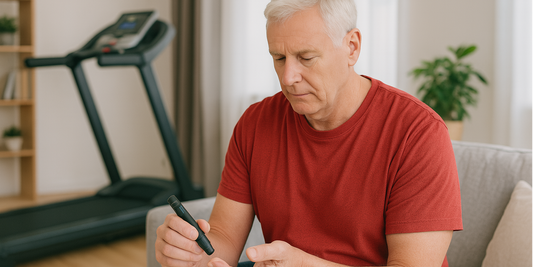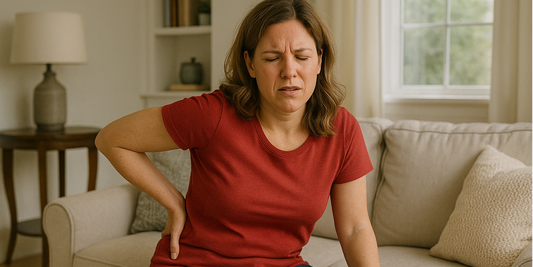
Relieving Lower Back Pain: How Gentle Walking Can Help You Heal
Share
Lower back pain is one of the most common health issues among adults, especially those over 40. Whether it's due to aging, sedentary habits, injury, or poor posture, this type of pain can significantly limit mobility and quality of life. Fortunately, many people can find relief not through intense workouts or expensive treatments, but through one of the simplest movements of all: walking.
And when done carefully and consistently, gentle walking, especially on a treadmill, can be a safe and effective way to reduce pain, support recovery, and build long-term spinal health. In this article, we’ll explore how walking helps relieve lower back pain, how to use a treadmill safely, and what to avoid during your healing journey.
Why Walking Helps with Lower Back Pain

Improves Circulation and Reduces Stiffness
When you're in pain, your natural reaction may be to rest. However, too much rest can actually worsen stiffness, weaken muscles, and slow healing. Walking promotes blood flow to the lower back, which brings oxygen and nutrients to tight or injured tissues. This circulation helps reduce inflammation, eases muscle tightness, and prevents your spine from becoming too rigid.
Activates Core Muscles and Encourages Natural Posture
Walking gently engages key muscle groups, including the abdominal muscles, glutes, and spinal stabilizers. These muscles are essential for maintaining balance and supporting the spine. When strengthened over time, they help take pressure off the lower back. Walking also encourages upright posture, which reduces the strain placed on your lumbar spine throughout the day.
The Benefits of Treadmill Walking for Back Pain

For those dealing with ongoing back pain or recovering from a back-related injury, walking outdoors can sometimes be risky. Uneven surfaces, unexpected slopes, or long distances may lead to setbacks. That’s where a treadmill can be especially helpful. Here’s why:
1 - Low-Impact on the Spine
Unlike hard surfaces like sidewalks or roads, most treadmills offer shock absorption to reduce joint and spinal impact. This cushioning is particularly helpful for people with degenerative disc issues or muscle tension in the lower back.
2 - Controlled Speed and Environment
You can walk at a consistent, gentle pace without worrying about outside conditions. Treadmills allow you to start as slow as 0.5 mph, then gradually increase your speed as your body becomes stronger and more comfortable.
3 - Supports Better Posture
Treadmills encourage even steps and upright positioning. There are no curbs or cracks to trip over, so you can focus entirely on form, keeping your shoulders relaxed, head high, and core engaged.
4 - Encourages Regular Activity
Having a treadmill at home makes it easier to build a consistent routine. Even if the weather is bad or you're short on time, a 10-minute walk is always within reach. And when it comes to back pain relief, consistency is key.
How to Start a Gentle Walking Routine

Starting small is the secret to long-term success, especially if you're recovering from back pain or just returning to exercise.
Start Slow and Short
Begin with just 5 to 10 minutes per session at a very low speed (0.5 to 1.5 mph). The goal isn't distance, it's comfort and control. As your endurance improves, you can increase your walking time in small increments (1 to 2 minutes per week).
Use Handrails and Focus on Posture
Use handrails for balance in the beginning, but try not to rely on them too much. Keep your head up, shoulders relaxed, and spine in a neutral position. Engage your abdominal muscles slightly to support your lower back as you walk.
Stick to Flat Settings
Keep the incline at zero in the early stages. Walking on an incline can place extra strain on the lower back muscles and may lead to discomfort if your spine is still healing.
What to Avoid When Walking with Back Pain

Knowing what not to do is just as important as doing the right things. Here are a few common mistakes to avoid:
No Incline or Long Sessions Early On
Even a mild incline increases spinal load. Keep your walk flat and short until you feel completely comfortable. Long sessions can lead to fatigue and poor posture, which might aggravate your symptoms.
Avoid Walking Through Sharp Pain
Some soreness or stiffness is okay, but sharp, sudden, or shooting pain is a red flag. If you feel pain increasing while walking, stop and rest. Pushing through pain can delay your recovery or cause setbacks.
Don’t Skip Warmups or Cooldowns
Even a short walk benefits from light stretching before and after. Gentle movements help your body transition in and out of activity, preventing strain and aiding flexibility.
Conclusion
Gentle walking is one of the safest and most effective ways to ease lower back pain. With a treadmill, you can walk comfortably at your own pace, build strength, and support long-term spine health, all from the safety of home.
The Redliro treadmill is a great option for this journey. With low starting speeds, a cushioned surface, and supportive handrails, it is designed to make recovery safer and more comfortable.



